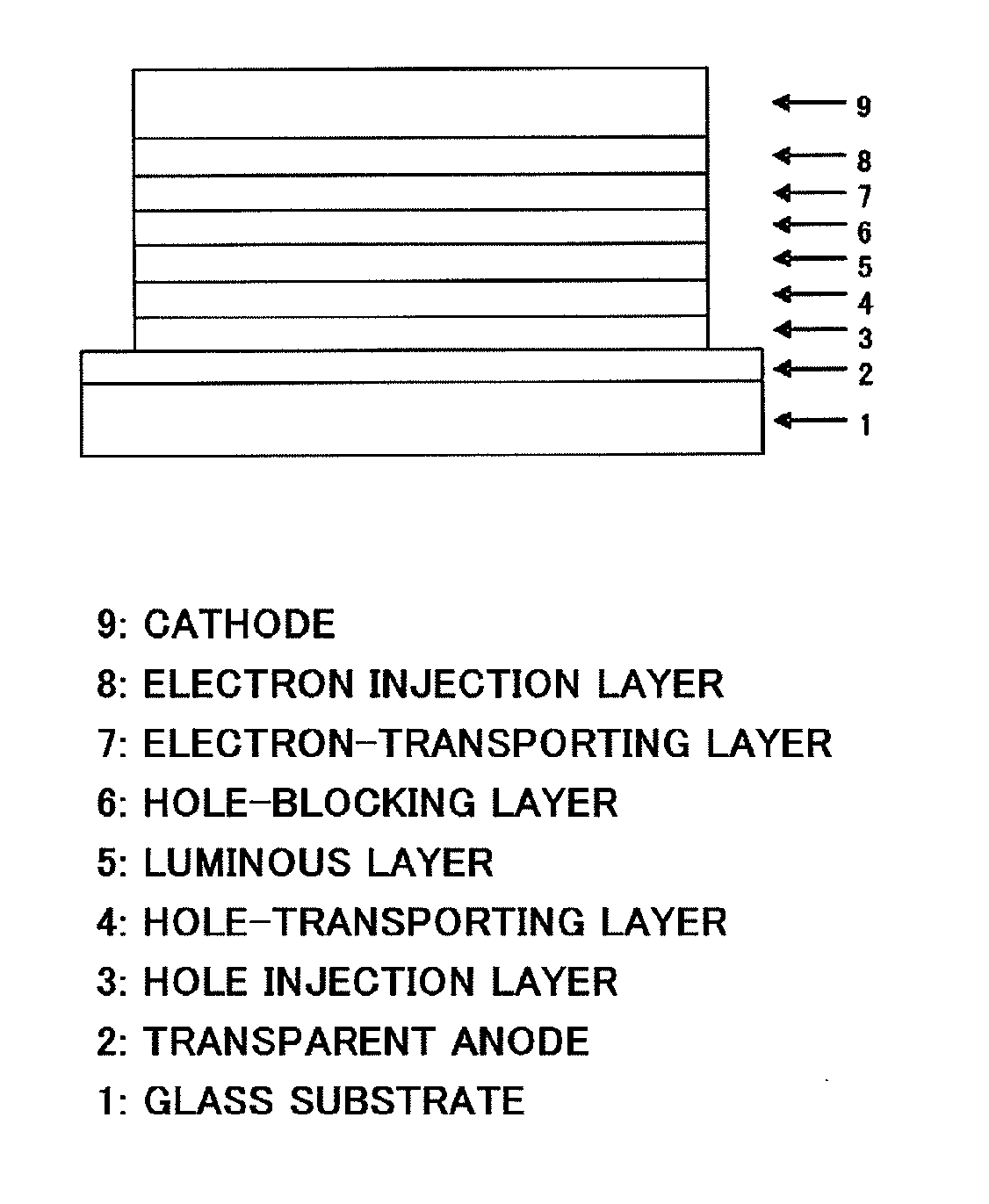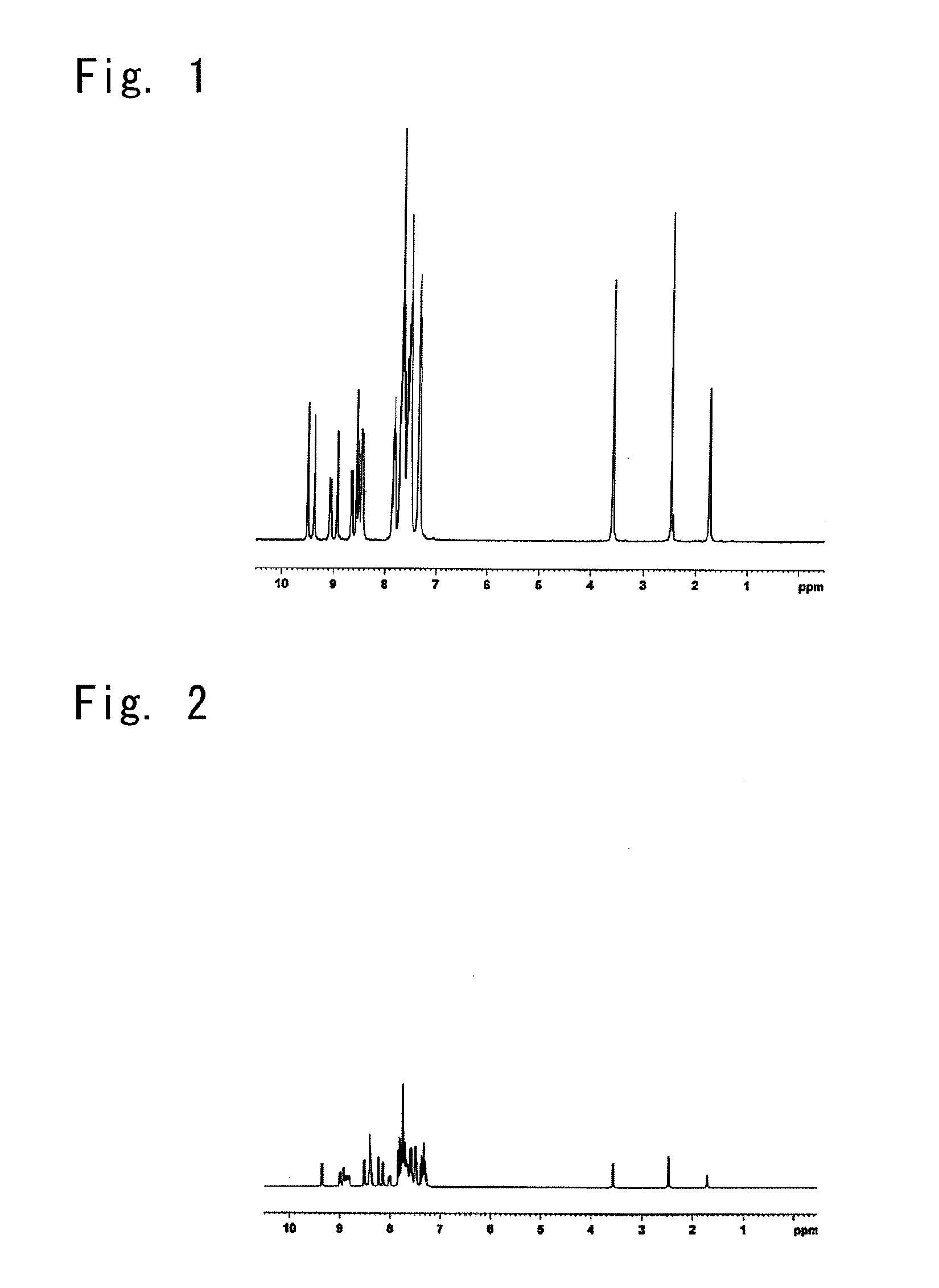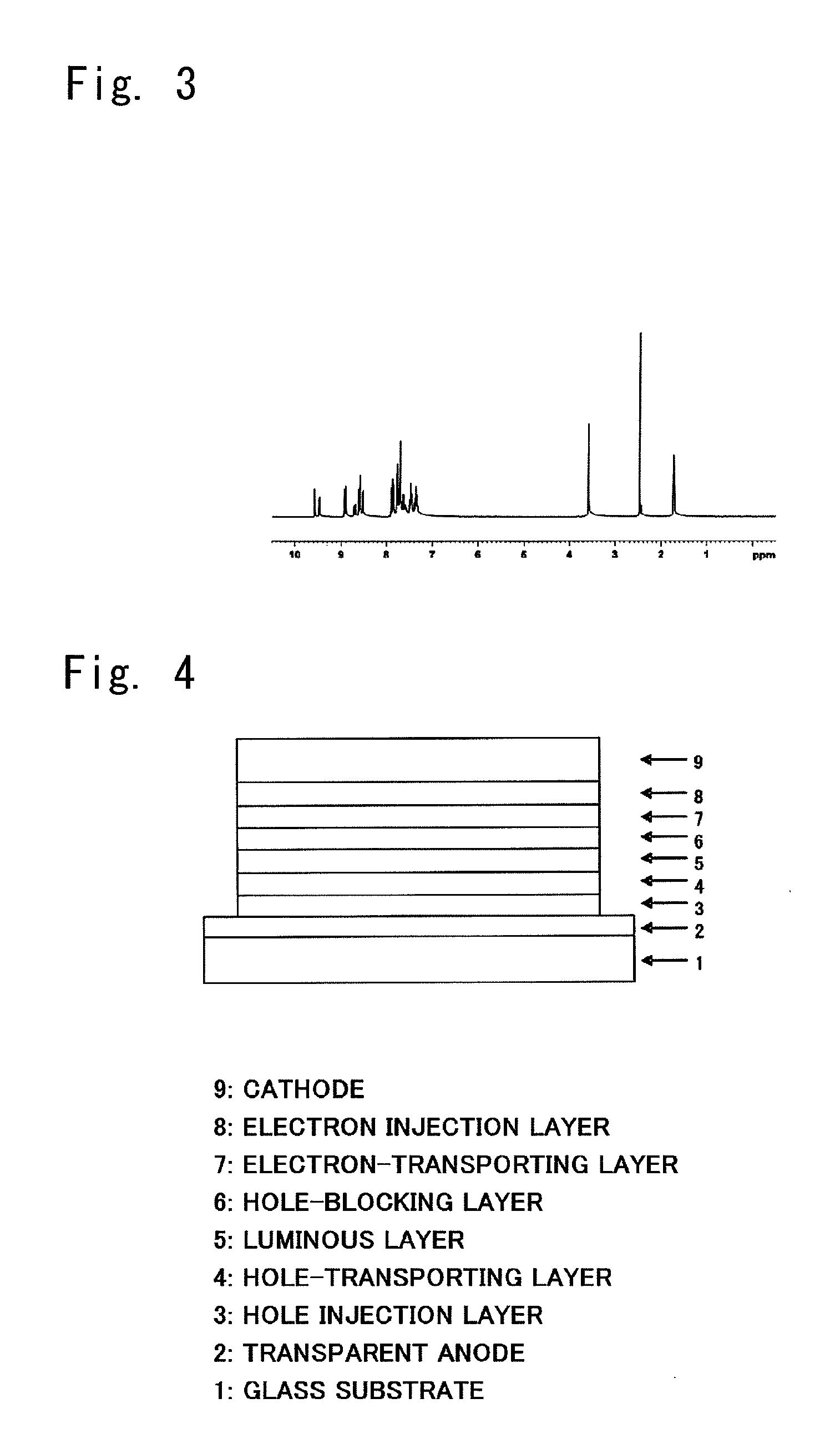Novel pyrimidine derivatives and organic electroluminescent devices
a technology of pyrimidine derivatives and organic electroluminescent devices, which is applied in the direction of organic chemistry, solid-state devices, thermoelectric devices, etc., can solve the problems of device deterioration, low hole-blocking power, and material with small heat resistance to be thermally decomposed, so as to improve electron transport efficiency and improve luminous efficiency , the effect of low driving voltag
- Summary
- Abstract
- Description
- Claims
- Application Information
AI Technical Summary
Benefits of technology
Problems solved by technology
Method used
Image
Examples
example 1
Synthesis of a 4-phenyl-2-[3-(10-phenylanthracene-9-il)phenyl]-6-(5-phenyl-5H-pyrido[4,3-b]indole-8-il)pyrimidine
Synthesis of a Compound 1
[0152][0153]2-Chloro-4-phenyl-6-(5-phenyl-5H-pyrido[4,3-b]indole-8-il)pyrimidine 4.4 g,[0154]3-(10-phenylanthracene-9-il)phenylboronic acid 4.6 g,[0155]Potassium carbonate 4.2 g,[0156]Tetrakis(triphenylphosphine) palladium 0.35 g,[0157]Toluene 40 ml,[0158]Ethanol 20 ml, and[0159]Water 20 ml,
were put into a reaction vessel purged with nitrogen, were heated and were stirred at 80° C. for 12 hours.
[0160]After cooled down to room temperature, methanol was added thereto, and the precipitated crude product was picked up by filtration and washed with water.
[0161]Next, the obtained crude product was refined by the column chromatography (carrier: silica gel, eluent: ethyl acetate / n-hexane) and was, thereafter, refined by the recrystallization by using a mixed solvent of toluene / hexane to obtain 5.1 g of a yellow powder of 4-phenyl-2-[3-(10-phenylanthracene...
example 2
Synthesis of a 4-(phenanthrene-9-il)-2-[3-{10-(5-phenyl-5H-pyrido[4,3-b]indole-8-il)anthracene-9-il}phenyl]-6-phenylpyrimidine
Synthesis of a Compound 35
[0175][0176]4-(Phenanthrene-9-il)-2-{3-(10-bromoanthracene-9-il)phenyl}-6-phenylpyrimidine 10.4 g,[0177](5-Phenyl-5H-pyrido[4,3-b]indole-8-il)-4,4,5,5-tetramethyl-[1,3,2]dioxaborane 6.7 g,[0178]Potassium carbonate 6.5 g,[0179]Tetrakistriphenylphosphinepalladium 0.54 g,[0180]Toluene 100 ml,[0181]Ethanol 50 ml, and[0182]Water 50 ml,
were put into a reaction vessel purged with nitrogen, and were stirred at 60° C. for 12 hours.
[0183]After cooled down to room temperature, the organic layer was picked up by the liquid separation operation. The organic layer was dehydrated with anhydrous magnesium sulfate and was, thereafter, concentrated under reduced pressure to obtain a crude product.
[0184]The obtained crude product was refined by the column chromatography (carrier: silica gel, eluent: ethyl acetate / n-hexane) and was, thereafter, refined ...
example 3
Synthesis of a 2,4-bis(biphenyl-4-il)-6-(5-phenyl-5H-pyrido[4,3-b]indole-8-il)pyrimidine
Synthesis of a Compound 72
[0198][0199]4-(Biphenyl-4-il)-2-chloro-6-(5-phenyl-5H-pyrido[4,3-b]indole-8-il)pyrimidine 8.2 g,[0200]Biphenyl-4-ilboronic acid 3.8 g,[0201]Potassium carbonate 6.7 g,[0202]Tetrakistriphenylphosphinepalladium 0.93 g,[0203]Toluene 82 ml,[0204]Ethanol 41 ml, and[0205]Water 41 ml,
were put into a reaction vessel purged with nitrogen, were heated and were stirred at 70° C. for 12 hours.
[0206]After cooled down to room temperature, heptane was added thereto, and the precipitated crude product was picked up by filtration. The obtained crude product was refined by the crystallization by using a mixed solvent of chlorobenzene / heptane and was refined by the crystallization by using a mixed solvent of methanol / heptane to obtain 4.0 g of a yellow powder of 2,4-bis(biphenyl-4-il)-6-(5-phenyl-5H-pyrido[4,3-b]indole-8-il)pyrimidine (compound 72) (yield, 40%).
[0207]The obtained yellow pow...
PUM
| Property | Measurement | Unit |
|---|---|---|
| voltage | aaaaa | aaaaa |
| brightness | aaaaa | aaaaa |
| work function | aaaaa | aaaaa |
Abstract
Description
Claims
Application Information
 Login to View More
Login to View More - R&D
- Intellectual Property
- Life Sciences
- Materials
- Tech Scout
- Unparalleled Data Quality
- Higher Quality Content
- 60% Fewer Hallucinations
Browse by: Latest US Patents, China's latest patents, Technical Efficacy Thesaurus, Application Domain, Technology Topic, Popular Technical Reports.
© 2025 PatSnap. All rights reserved.Legal|Privacy policy|Modern Slavery Act Transparency Statement|Sitemap|About US| Contact US: help@patsnap.com



